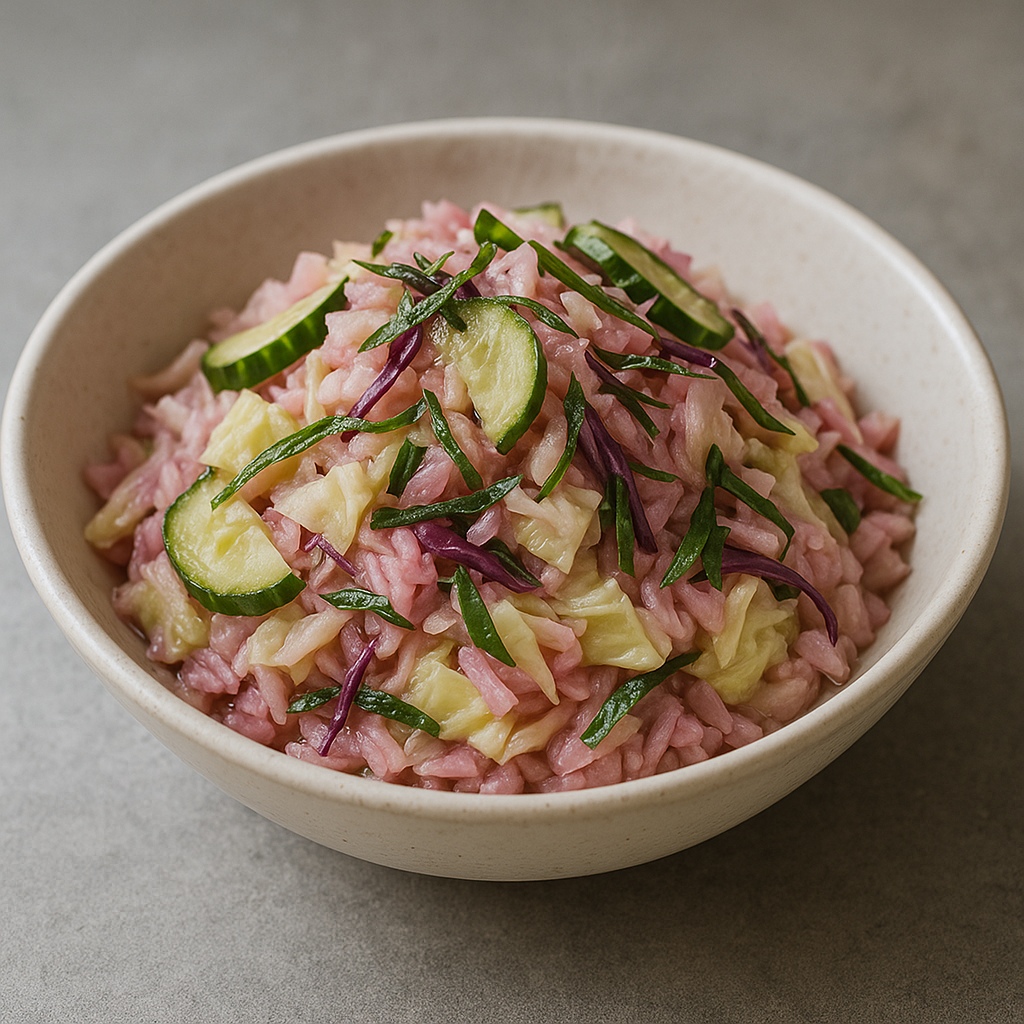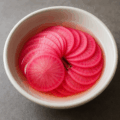すしこの特徴
津軽西北に伝わる“ごはんの漬物”
「すしこ」は、蒸したもち米に赤じそや紫キャベツ、きゅうりの古漬けなどを合わせ、乳酸発酵させた津軽西北地域の郷土食。ごはんのおかずにごはんとして食べられてきた、きわめてユニークな一品です。別名「赤めし」。冬の保存食や農作業時の携行食として重宝されました。
赤じそ&紫キャベツの自然な発色
下処理した赤じそや紫キャベツの色素がもち米に移り、食欲をそそる鮮やかな紅色に。乳酸発酵が進むほど酸味が増し、爽やかな甘酸っぱさにまとまります。
“いずし”との違い
魚や麹を用いる飯ずし(いずし)に対し、すしこは主に米と野菜で仕立てるのが特徴。地域の発酵文化の中で育まれた“ごはんの漬物”です。
すしこのレシピ
材料(作りやすい量/約6〜8人分)
- もち米 … 300g(2合)
- きゅうり … 3本(塩もみ)
- 赤じその葉 … 60g(塩もみしてアク抜き)
- 紫キャベツ … 300g(塩もみ→酢・砂糖少々でもんで色出し)
- 赤唐辛子 … 1/3本(小口切り)
- 酢 … 大さじ1〜2
- 砂糖 … 小さじ1
- 塩 … 少々(味の調整)
作り方
- 下ごしらえ:きゅうりは薄切りしてから塩もみ、赤じそ・紫キャベツは別々に塩もみ→水洗い→水気をしぼる。紫キャベツは酢と砂糖を少量加えてさらにもみ、色素を引き出す。
- もち米:固めに蒸す(または炊く)。粗熱をとる。
- 色づけ:ボウルで冷ましたもちごはんに、紫キャベツから出た“色汁”を回しかけ、むらなくほぐして淡い紅色にする。赤唐辛子を混ぜる。
- 合わせる:紫キャベツ→刻んだきゅうり→赤じその順に加え、酢と砂糖を少量ずつ。塩で味を調える。
- 漬ける:消毒した容器に入れ、落としラップ+軽い重し。冷蔵(5〜8℃目安)で半日〜1日おいてなじませる。
- 提供:汁気を軽く切って器へ。炊きたてご飯の“おかず”として少量ずつどうぞ。
シェフのワンポイントアドバイス
- 発酵させるキュウリを用意するのがやや難しい為、家庭では無発酵のレシピを記載しました。
- 紫キャベツの“色汁”で着色→具を重ねる順に混ぜると、米がベタつかず美しく仕上がります。
栄養価(1人分の目安)
- エネルギー:約120〜180 kcal
- たんぱく質:2〜4 g/脂質:0〜2 g/炭水化物:25〜38 g
主食系の発酵おかず。少量で満足感があり、暑い時季でも食べやすい味わいです。
歴史
米どころ津軽の保存食文化から
江戸期に開墾が進んだ津軽西北では、家庭ごとに一斗樽で仕込み、冬の間の保存食に。田の仕事の合間の栄養補給としても親しまれ、「赤めし」と呼ばれることもあります。
受け継がれる“ごはんの漬物”
近年は作り手が減りつつも、道の駅や加工グループの商品化、メディア紹介などで継承の動きが広がっています。
English Version
Features of Sushiko
A “rice pickle” from Northwestern Tsugaru
Sushiko is a local dish in which steamed glutinous rice is combined with red shiso, purple cabbage, and salted cucumbers, then (traditionally) lightly lactic-fermented. It’s a uniquely Tsugaru idea—rice as a side for rice. Also known as “aka-meshi” (“red rice”), it served as a winter preserve and a portable bite during farm work.
Natural color from red shiso & purple cabbage
Pigments from pretreated red shiso and purple cabbage tint the rice a vivid pinkish red. As fermentation progresses, acidity rises and the flavor settles into a refreshing sweet-tart balance.
How it differs from “izushi”
Unlike izushi (rice sushi) that uses fish and koji, sushiko is built mainly from rice and vegetables—a “rice pickle” nurtured by the region’s fermentation culture.
Recipe
Ingredients (about 6–8 servings)
- Glutinous rice … 300 g (about 2 rice cups)
- Cucumbers … 3 (thinly sliced; salted and squeezed)
- Red shiso leaves … 60 g (salt-massaged, rinsed, well squeezed)
- Purple cabbage … 300 g (salt-massaged, then rubbed with a little vinegar & sugar to draw out color)
- Dried red chili … 1/3 (thinly sliced)
- Vinegar … 1–2 tbsp
- Sugar … 1 tsp
- Salt … a pinch (to adjust)
Instructions
- Prep: Salt the cucumber slices, leave briefly, then rinse and squeeze well. For red shiso and purple cabbage, salt-massage each separately, rinse, and squeeze dry. For the cabbage, rub in a little vinegar and sugar to express a richly colored “juice.”
- Cook rice: Steam (or cook) the glutinous rice slightly firm. Cool to lukewarm.
- Tint the rice: In a bowl, sprinkle the cabbage “color juice” over the cooled rice and loosen gently until evenly pink. Mix in the chili.
- Combine: Fold in the purple cabbage → squeezed cucumbers → red shiso, in that order. Season with vinegar and sugar in small additions; fine-tune with a pinch of salt.
- Meld: Pack into a sanitized container, press plastic wrap directly on the surface, and set a light weight on top. Refrigerate at 5–8 °C for ½–1 day to let flavors settle.
- Serve: Lightly drain and plate. Enjoy a small amount alongside freshly cooked rice—rice as a “rice condiment.”
Chef’s Tips
- This is a quick, non-fermented home version (traditional recipes used pre-fermented cucumbers and short lactic fermentation). If acidity is too gentle, add a splash more vinegar; if too sharp, a pinch of sugar rounds it out.
- For a clean look and non-sticky grains, first tint the rice with the cabbage juice, then layer in the vegetables in sequence.
Nutritional Value (per serving, approx.)
- Calories: ~120–180 kcal
- Protein: 2–4 g / Fat: 0–2 g / Carbohydrates: 25–38 g
A rice-based fermented-style side. Small portions satisfy, and the light sweet-tart profile eats well even in warm seasons.
History
Born of Tsugaru’s rice-belt preservation culture
As fields expanded in the Edo era, households in northwestern Tsugaru packed sushiko into large tubs for winter keeping. It also fueled labor during fieldwork and is sometimes called “aka-meshi.”
A “rice pickle” carried forward
Though fewer people make it at home today, production by local groups, roadside markets, and media features are helping pass the tradition on.



何でも質問してください!